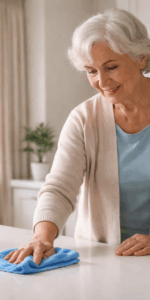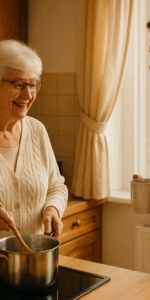For many of us, the phrase “Occupational Therapy” might conjure images of clinical settings, hospital rooms, or rehabilitation centres. But for thousands of people across the UK, the real magic of occupational therapy happens far beyond the walls of a clinic. It takes place in the home, the community, and often, in the most unexpected of moments.
We had the chance to speak with Daisy, a community occupational therapist working across Devon, who generously shared a glimpse into her day-to-day work. As she explains, no two days are ever quite the same.
Morning Visits: More Than Just Mobility
“Most mornings start early,” Daisy tells us. “I usually have a few home visits scheduled by 9am. Today, I’m seeing a gentleman recently discharged from hospital after a fall.”
Daisy’s goal is to make sure he can safely navigate his home, reduce his risk of another fall, and regain confidence in doing the things he loves—even something as simple as making a cup of tea.
“When someone loses confidence in everyday tasks, it doesn’t just affect their routine. It affects their identity,” she explains. “Something as small as pouring a cup of tea without fear can restore dignity.”
Adapting, Not Just Assessing
Unlike therapists in hospital settings, community OTs like Daisy work closely with patients in their real-world environments.
“You’re not just looking at a person’s physical ability,” she says. “You’re looking at the layout of the home, the lighting, the clutter, the cupboard heights, the flooring. It all plays a role.”
Daisy works with clients who may be recovering from stroke, managing Parkinson’s, living with arthritis, or experiencing the general effects of aging. Some have support from family. Many live alone.
Lunch in the Car, Heart on the Job
“I usually eat lunch in the car between visits. It gives me a minute to catch up on notes, return a few calls, or just breathe. Sometimes the emotional load can be heavy. You’re seeing people at vulnerable moments.”
She recalls a recent client who was referred by a concerned neighbour. “She hadn’t been eating properly because she struggled to open tins and couldn’t safely carry hot drinks. These seem like little things. But they’re not. They matter hugely.”
Small Aids, Big Impact
We ask Daisy what she thinks about the growing role of daily living aids in the home.
“Assistive products are part of the solution—not the whole answer, but an important piece. It’s about matching the right product to the right person at the right time.”
She mentions that she’s familiar with the Uccello Kettle and has recommended it to several clients already.
“There are definitely cases where I’ve seen a visible difference. One lady told me it was the first time in months she’d made her own tea without help. Her daughter said she’s been brighter ever since. That’s what we work for.”
Afternoon Admin and Advocacy
By the afternoon, Daisy’s juggling follow-up calls with GPs, coordinating with social services, and preparing reports. It’s the less glamorous side of the job, but vital for keeping care consistent and clients safe.
“There’s a lot of advocating involved,” she adds. “Sometimes it’s about getting the right equipment, but sometimes it’s just making sure someone isn’t slipping through the cracks.”
Why Community OTs Matter
Community occupational therapists do more than recommend grab rails or walking aids. They restore dignity, reduce isolation, and empower people to live independently in their own homes.
“The job isn’t always easy,” Daisy admits. “But when someone calls you weeks later to say they feel like themselves again, that’s when you know you’re doing something worthwhile.”
As the UK population continues to age, the role of community OTs like Daisy has never been more crucial. They’re the quiet champions behind safer homes, brighter mornings, and everyday wins that help people stay where they belong: in the comfort and familiarity of home.













Leave a Comment